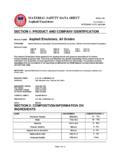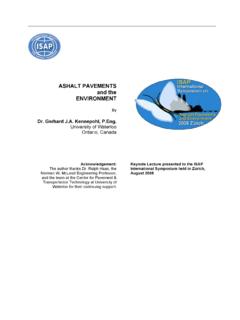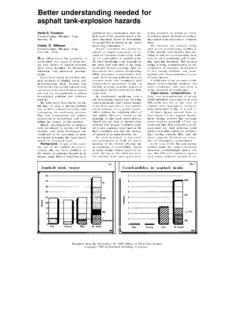Transcription of Development of a low temperature crumb rubber binder for ...
1 Development of a low temperature crumb rubber binder for spray sealing Alexandru L Let, Trevor Distin Abstract Bitumen modified with crumb rubber recovered from used vehicle tyres has been used very successfully in spray applications for many years in Australia. The presence of the rubber improves the properties of the binder and the natural rubber component increases the binder 's ability to hold aggregate in place. However one of the major draw backs of using crumb rubber binder in spray sealing applications is the degradation of the binder properties at high application temperatures . In this paper bitumen modified with crumb rubber and special additives have been studied to improve the storage stability of the rheological properties of the modified binder .
2 The paper also sets out to demonstrate that with special additives crumb rubber can be used in a more environmental friendly and safer manner as a modifier by enabling the binder to be blended and sprayed at a lower temperature without compromising the performance of the seal. Background The utilization of scrap tire rubber in asphalt started in the mid-1960s when crumb rubber was placed in asphalt surface treatments, such as chip seal application. Later on, in the 1970 s, crumb rubber modified asphalt chip seals were used as a stress absorbing membranes interlayer. It use has been extended to hot mix asphalt and has continued to evolve due to the rubber s enhancement of mixture performance including improved rutting resistance, thermal reflective cracks resistance, and resistance to fatigue cracking.
3 Some other benefits reported include reduction in maintenance, smooth ride, good risk resistance, and noise reduction (1,2,3,4). crumb rubber modified binders can perform equivalently to polymer modified binders and can be used as a substitute for using polymers in asphalt and spray seal binders. In terms of environmental issues, the disposal of scrap tires is a major waste management concern due to used tires being placed in scrap tire piles and landfills. These stock piles of used tyres become a health risk because they become breeding grounds for mosquitoes and fire hazards. The rubber composition of tyres contains both natural and synthetic rubber compounds which can be reactivated to react with the bitumen.
4 crumb rubber from used vehicle tyres is a natural resource of polymers for the local road surfacing industry which negates the need to import expensive polymers into Australia thereby helping the balance of payments and reducing our carbon footprint. The carbon black in the tyre compound is an antioxidant. This helps improve the durability of the binder in the spray seal from the sun s ultra rays and oxidisation. It has been established that interaction between crumb rubber and bitumen is a physical reaction on in which the crumb rubber absorb a portion of the aromatic fraction of the bitumen through diffusion, resulting in swelling of the crumb rubber particles. This particle swelling compounded with the reduction in the oily fraction of the bitumen results in an increase in the crumb rubber binder viscosity.
5 The interaction becomes chemical when the crumb rubber is chemically modified and is used as additive for polymer modified binder . The addition of 10 wt% crumb rubber to C170 base bitumen yielded similar rheological characteristics to those shown by the same bitumen modified with 3 wt% SBS, a polymer widely used to manufacture polymer modified bitumen. 14%27%28%15%16%27%14%28%16%15%Passenger TireTruck TireFabric, Fillers,antiozonantsSteelCarbon BlackSynthetic RubberNatural rubber Figure 1 Composition of vehicle tyres Due to its visco-elastic properties, the product must be handled at very high temperatures . As a consequence this results in the binder having and a limited shelf-life at these elevated temperatures .
6 The crumb rubber binder should be cut back with a lighter petroleum distillate like kerosene just before the binder is sprayed to the pavement surface to reduce its viscosity. The application of crumb rubber bitumen in spray sealing is complicated by its limited shelf-life at high temperature and paving crews and sprayer operators dislike the odours associated to the product. These concerns can largely be addressed by lowering the handling and application temperatures . To this end laboratory trials were undertaken to see if the temperature at which crumb rubber bitumen could be blended could be reduced to achieve a more storage stable product. The secondary consideration would be to also negate the need to add petroleum cutters and thereby reduce the fuming which is associated with spraying crumb rubber bitumen at high temperatures of 200 C.
7 Figure 2 Field blending of conventional crumb rubber bitumen Experimental Design Conventional bitumen rubber blends containing 15% crumb rubber by mass of bitumen were prepared at three temperatures , 190, 200 and 210 C using a mixer IKA 20R from IKA (Germany). low temperature crumb rubber bitumen blends were prepared from base bitumen C170 and 15% rubber with a low temperature additives. The base bitumen was preheated to 190 C, the additives were added, followed by the addition of the rubber crumbs. The temperature of the respective blends was dropped to 170 C and was maintained at this temperature in an oven. The torsional recovery of all the blends was monitored over time against the specification range.
8 Time zero represents the case when all the components have been combined and mixed for 30 minutes at digestion temperature . All the bitumen rubber blends were placed in an oven heated and maintained at their reaction temperature . The softening point has been determined with the Matest - automatic Ring and Ball apparatus according AG:PT/T131. The torsional recovery was measured according AG:PT/T122 using torsional recovery apparatus that operates by manually rotating. The softening point and torsional recovery measurements were performed at hourly intervals until the results were out of the specifications limits of AGPT/T190 Specifications framework for crumb rubber binder .
9 The viscosity was determined with a hand held Rion Viscometer (similar to Haake viscometer). Figure 1 illustrates the experimental design followed this study. The crumb rubber binder properties requires by Austroads specification AG:PT/T190 are softening point and torsional recovery (Table 1). Figure 2 Flow chart of experimental design procedures for evaluating the new crumb rubber technology for spray seal application Table 1 Reological binder property requirements for field blended crumb rubber Bitumen Property S15RF S18RF Method Normal rubber Concentration, [%] 15 18 rubber Content by analysis, [%] 13 16 AGPT/T142 Softening Point, [ C] min. 55 62 AGPT/T131 Torsional Recovery, [%] min 25 30 AGPT/T122 The additives used to produce the low temperature crumb rubber bitumen technology are special waxes named WB and WBS.
10 Results and Discussions The crumb rubber binder is formulated and reacted at elevated temperatures and under high agitation to promote the physical interaction of the base bitumen and the crumb rubber constituents. The crumb rubber binder used for spray application requires high crumb rubber contents and should be obtained by the wet blending process. The wet process as developed by Mc Donald in the late 1960s the ground tyre rubber interacted with base bitumen at elevated temperature . In Figure 3, the typical behaviour of conventional crumb rubber binder when stored over time at three different elevated temperatures . This set of data shows a shift in the peak and rate of deterioration in the torsional recovery properties when the temperature is dropped from 210 C to 190 C.






